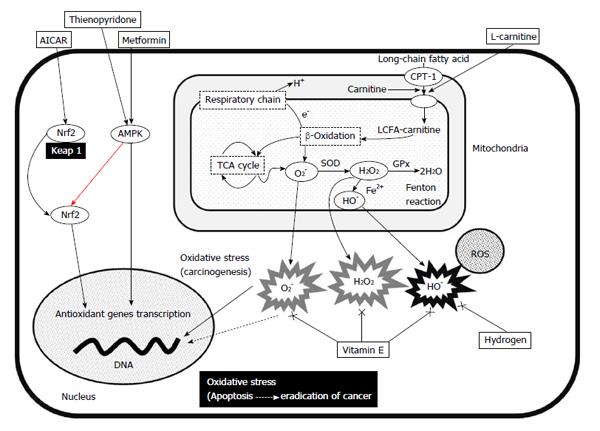Copyright
©The Author(s) 2015.
World J Hepatol. May 8, 2015; 7(7): 968-979
Published online May 8, 2015. doi: 10.4254/wjh.v7.i7.968
Published online May 8, 2015. doi: 10.4254/wjh.v7.i7.968
Figure 1 Oxidative stress production and treatment targets in hepatocytes.
High levels of plasma free fatty acids increase levels of hepatic free fatty acids. Long-chain fatty acids taken up by mitochondria as complexes with L-carnitine are subsequently metabolized in β-oxidation pathway. Under oxidative stress, oxidative reactions convert oxidized cofactors (NAD+ and FAD) into reduced cofactors (NADH and FADH2) and deliver electrons to respiratory chain. Imbalance between increased delivery of electrons to, and decreased outflow from respiratory chain causes electrons and ROS products to accumulate. Antioxidant defenses, such as superoxide dismutase (SOD), glutathione peroxidase (GPx) or catalase can metabolize O2- and H2O2 to non-toxic H2O. However, Fenton and/or Haber-Weiss reactions generate highly reactive, toxic, hydroxyl radicals (•OH). Vitamin E and hydrogen as general and selective cytotoxic ROS scavengers erase oxidative stress. L-carnitine supports mitochondrial function to increase long-chain fatty acid uptake. Metformin or thienopyridone activates AMPK and induces antioxidant gene transcription and AICAR activates Nrf2, possibly like metformin. AICAR: 5-aminoimidazole-4-carboxamide-1-b-D-ribofuranoside; AMPK: AMP-activated protein kinase; Keap1: Kelch-like ECH associating protein; Nrf2: Nuclear factor erythroid 2-related factor.
- Citation: Takaki A, Yamamoto K. Control of oxidative stress in hepatocellular carcinoma: Helpful or harmful? World J Hepatol 2015; 7(7): 968-979
- URL: https://www.wjgnet.com/1948-5182/full/v7/i7/968.htm
- DOI: https://dx.doi.org/10.4254/wjh.v7.i7.968













